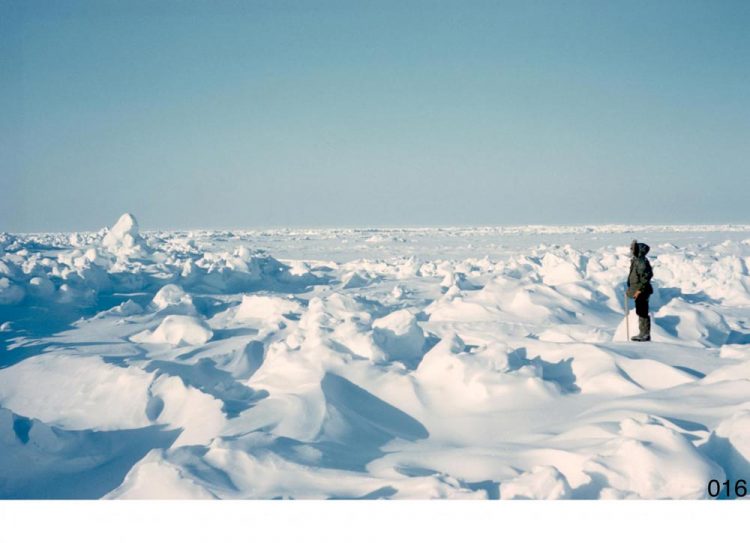Solving the problem of sea ice thickness distribution using molecular concepts

Arctic ice, in 1957, is shown. Credit: Norbert Untersteiner
Although today's highly precise satellites do a fine job of measuring the area of sea ice, measuring the volume has always been a tricky business.
The volume is reflected through the distribution of sea ice thickness — which is subject to a number of complex processes, such as growth, melting, ridging, rafting, and the formation of open water.
For decades, scientists have been guided by a 1975 theory (by Thorndike et al.) that could not be completely tested, due to the unwieldy nature of sea ice thickness distribution.
The theory relied upon an intransigent term — one that could not be related to the others — to represent the mechanical redistribution of ice thickness. As a result, the complete theory could not be mathematically tested.
Enter Yale professor John Wettlaufer, inspired by the staff and students at the Geophysical Fluid Dynamics Summer Study Program at the Woods Hole Oceanographic Institution, in Massachusetts.
Over the course of the summer, Wettlaufer and Yale graduate student Srikanth Toppaladoddi developed and articulated a new way of thinking about the space-time evolution of sea ice thickness.
The resulting paper appears in the Sept. 17 edition of the journal Physical Review Letters.
“The Arctic is a bellwether of the global climate, which is our focus. What we have done in our paper is to translate concepts used in the microscopic world into terms appropriate to this problem essential to climate,” said Wettlaufer, who is the A.M. Bateman Professor of Geophysics, Mathematics and Physics at Yale.
Wettlaufer and co-author Toppaladoddi recast the old theory into an equation similar to a Fokker-Planck equation, a partial differential equation used in statistical mechanics to predict the probability of finding microscopic particles in a given position under the influence of random forces. By doing this, the equation could capture the dynamic and thermodynamic forces at work within polar sea ice.
“We transformed the intransigent term into something tractable and — poof — solved it,” Wettlaufer said.
The researchers said their equation opens up the study of this aspect of climate science to a variety of methods normally used in nonequilibrium statistical mechanics.
Media Contact
All latest news from the category: Earth Sciences
Earth Sciences (also referred to as Geosciences), which deals with basic issues surrounding our planet, plays a vital role in the area of energy and raw materials supply.
Earth Sciences comprises subjects such as geology, geography, geological informatics, paleontology, mineralogy, petrography, crystallography, geophysics, geodesy, glaciology, cartography, photogrammetry, meteorology and seismology, early-warning systems, earthquake research and polar research.
Newest articles

NASA: Mystery of life’s handedness deepens
The mystery of why life uses molecules with specific orientations has deepened with a NASA-funded discovery that RNA — a key molecule thought to have potentially held the instructions for…

What are the effects of historic lithium mining on water quality?
Study reveals low levels of common contaminants but high levels of other elements in waters associated with an abandoned lithium mine. Lithium ore and mining waste from a historic lithium…

Quantum-inspired design boosts efficiency of heat-to-electricity conversion
Rice engineers take unconventional route to improving thermophotovoltaic systems. Researchers at Rice University have found a new way to improve a key element of thermophotovoltaic (TPV) systems, which convert heat…



